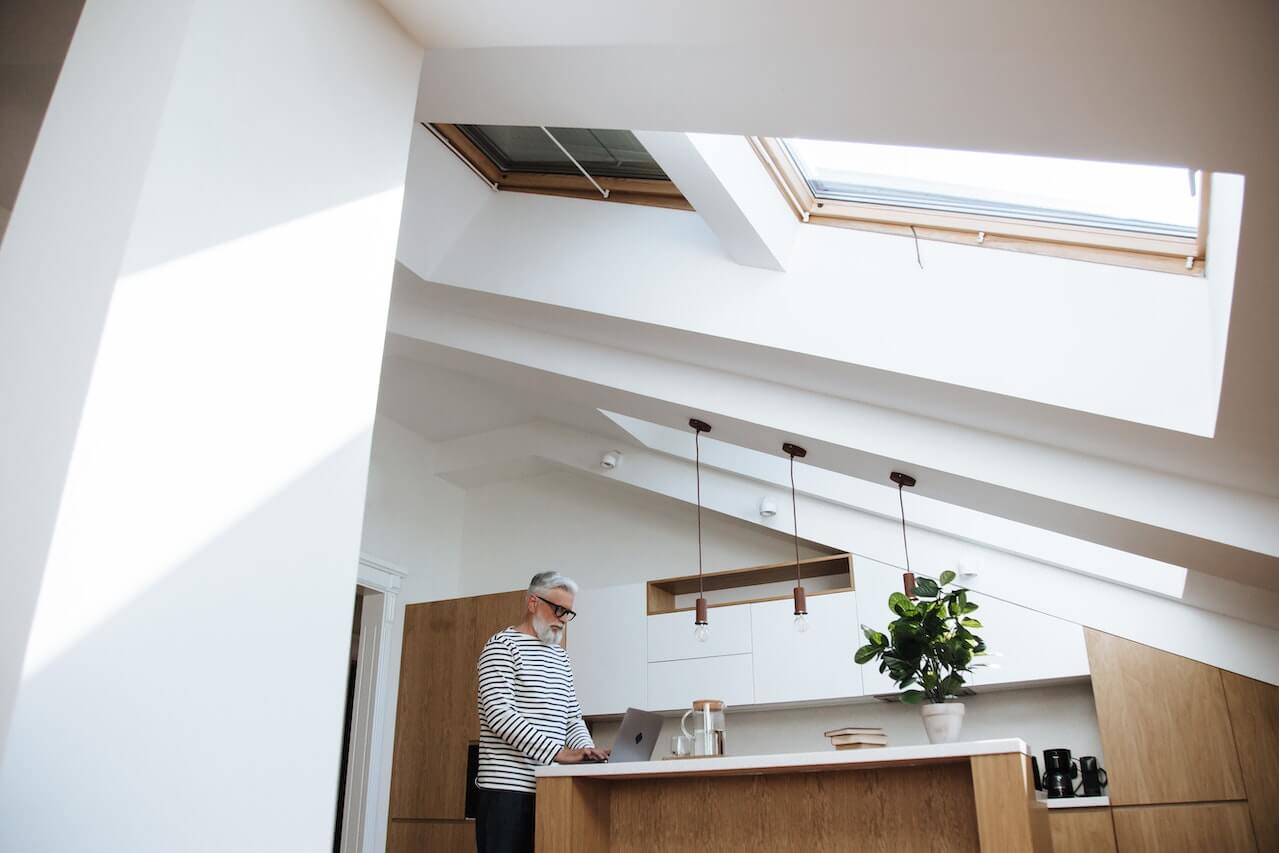Table of Contents
Inviting enough sunlight indoors isn’t only about aesthetics, though that’s certainly an important consideration, as a dark room can take a toll on your mood and make you feel sluggish. It’s also about energy efficiency — the more natural light you let in, the less artificial light or heating you’ll need, thereby saving money and reducing your carbon footprint.
However, not all homes are built to maximize sunlight. Some rooms may be too big or awkwardly shaped to get much light, while others may have windows that face the wrong direction or are blocked by trees or other buildings.
If your home falls into one of these categories, not all is lost — you can still bring sunlight indoors byinstalling a window on your roof.
Flat roof windows are a type of skylight designed to be installed in a flat or nearly-flat roof. They’re available in a variety of sizes, shapes, and styles to suit any need and can even be fitted with electric blinds or shades for added privacy or light control.
Still, there are a few things to keep in mind when shopping for flat roof windows. Below, we’ve put together a buyer’s guide with all the information you need to choose the right roof windows for your home.
Know the Types of Popular Flat Roof Windows
The first thing to consider when shopping for flat roof windows is what type of window you want. Here at Sunlux, we offer four of the most popular types on the market:
- Fixed flat glass rooflights: As the name suggests, these roof windows are fixed in place and cannot be opened. They have three significant advantages: they’re very energy efficient (since there’s no way for outside air to enter), low maintenance, and resistant to various types of weather damage.
- Hinged flat glass rooflights: Hinged windows can be opened for ventilation, allowing fresh air into a property. You can choose electric or manually-operated windows.
- Access flat glass rooflights: Access windows are hinged as well, but they open all the way, providing easy access to the roof for maintenance or repairs. These windows are ideal if you have a living space on your roof, like a deck or a patio. They’re also available in electric or manual versions.
- Walk-on flat glass rooflights: Walk-on rooflights are designed to be strong enough to support the weight of a person, making them ideal for roof decks, patios, a flat roof extension, or other areas where people will be walking. They’re also available in electric or manual versions.
Where to Install Flat Roof Windows
There aren’t many limitations on where you can install flat roof windows. In fact, apart from the obvious (like making sure the flat rooflight will fit in the space), the only real consideration is whether your roof is between 0° and 15° (degrees) in pitch. If it is, then you can install a flat roof window.
Then, you have to consider the purpose of the window. For example, if you have an office in your house, you probably want to maximize natural lighting in your working area. In this case, you have to add a window to provide task lighting and consider the position of your computer screen to avoid glare.
In such a situation, your window will be placed differently than if you want to install it in darker rooms to provide general lighting and a view. It will allow for more light without interrupting your work.
Moreover, you must ensure it’s possible to reach the window to clean it, especially if it’s openable. Depending on the type of window you choose, installing a ladder or other access equipment may be necessary.
Decide on the Right Size
The next thing you need to do is choose the right size for your rooflight. This factor is usually determined by the amount of space you have available on your roof, as well as the purpose of the window.
Depending on how much natural light you want to let in, you may need a larger or smaller rooflight. However, finding the perfect balance is crucial, as a window that’s too small won’t provide enough light, while one that’s too large can make you feel like you’re living in a fishbowl.
Keep in mind that the bigger the window, the more heat it will let in during summer — something to consider if your home tends to get very hot.
If you’re unsure what size to choose, asking a professional for advice is always a good option. They’ll be able to take measurements and help you choose the right size for your needs.
Research the Glazing Options
The next thing you need to consider is the glazing. This is the glass or plastic that makes up the window, and it’s available in a variety of options. The most popular are single, double, and triple-glazed windows.
- Single-glazed windows are the most basic and least energy-efficient. They are made with a single layer of glass, and no gas is used to fill the space between panes. It’s the cheapest option, but it offers very little in terms of temperature and sound insulation, so it’s not ideal if you live in a cold climate.
- Double-glazed windows have two layers of glass, with a layer of gas in between. This gas helps to insulate the window, improving its energy performance. The most common types of gas used in double-glazed windows are argon and krypton.
- Triple-glazed windows have three layers of glass and two layers of gas. It makes them the most energy-efficient option, as well as the most expensive.
Consider Different Window Materials
While flat glass rooflights are undoubtedly the most common, they’re not the only option. You can also choose from acrylic and polycarbonate. Check all the available options to select the right material for your needs.
- Glass-covered is the classic choice, and it offers a few advantages. It has a long lifespan, is easy to clean, and provides excellent insulation. However, it can still break, especially if you live in an area with severe weather conditions.
- Acrylic is a type of plastic similar to glass, but it’s much lighter and less likely to break. It also has a higher level of light transmittance, meaning it lets in more natural light than glass. Unfortunately, it’s not heat-resistant and can easily get scratched.
- Polycarbonate is another type of plastic, and it’s even stronger than acrylic. It’s virtually unbreakable, making it a good choice if you live in an area with severe weather conditions. The downside is that it’s sensitive to scratches and can expand.
Choose the Type of Glass
The type of glass you choose will also affect your window’s energy efficiency and the amount of light it lets in. The most popular options are clear, tinted, and reflective flat glass windows.
- Clear glass is the standard option and offers the best clarity. However, it doesn’t do much to reduce heat gain or glare. It’s the best option if you need to let a lot of light in, but it’s not the most energy-efficient.
- Tinted glass is an excellent option to reduce heat gain, as it blocks some of the sun’s rays. It’s also available in a variety of tints, so you can choose one that offers the perfect balance of natural light and privacy.
- Reflective glass is coated with a metallic oxide that reflects some of the sun’s rays. This factor makes it a good option for reducing heat gain, as well as for reducing glare. It’s also available in a variety of tints.
Pick the Right Finish
The final thing to consider is the finish. It’s the material used to frame the window, and it’s available in various options, including wood, aluminium, PVC, and fibreglass.
- Wood is a classic option that’s been used for centuries. It’s a good insulator and offers a lot of aesthetic appeals. However, it requires more maintenance than other options and isn’t as durable.
- Aluminium is a popular choice for flat roof windows, as it’s strong and durable. It’s also a good conductor of heat, so it can help to reduce heat loss. However, it’s not as good at insulating against noise.
- PVC is a synthetic material that’s becoming increasingly popular for windows. It’s a good insulator and is available in a variety of colours. It’s also low maintenance and easy to clean.
- Fibreglass is another synthetic material that’s becoming popular for windows. It’s solid and durable, and it doesn’t corrode. It’s also a good insulator and is available in a variety of colours.
FAQ
To provide further help and guidance, we have compiled a list of frequently asked questions about flat rooflights. If you have any other queries, please do not hesitate to contact us.
What windows can you have on a flat roof?
The most popular type of flat rooflight is a skylight. However, there are a few other options, such as Velux windows and dormer windows.
Can you fit VELUX windows on a flat roof?
Yes, you can. VELUX windows offer models designed to be installed on both pitched and flat roofs.
Can you have a skylight on a flat roof?
Yes, skylights are designed to be installed on both pitched and flat roofs.
Do I need permission to put a window on my roof?
It depends on your specific situation. You may need planning permission from your local council or another body if you live in a listed building or conservation area or if the window is too large or too close to the property boundary.
What pitch do I need for a flat roof window?
Your roof must have a pitch between 0° and 15° for a flat roof window to be installed.
Do you need scaffolding to install roof windows?
It depends on the type of window you’re installing and the roof pitches.
Why do skylights need a 15-degree pitch?
Skylights need a 15-degree pitch to ensure proper natural drainage. Otherwise, water could enter the skylight and cause damage to your property.
What pitch should a roof be in the UK?
The minimum pitch for a roof in the UK is 15 degrees.
How much gap do you leave around a roof window?
It is best to leave a gap of at least 60mm around the outside flat rooflights.
Do I need to double rafters for rooflights?
It depends on the size and weight of the rooflight. You should always check with the manufacturer to see if double rafters are required.
What type of skylight is best for a flat roof?
There’s no definitive answer, as there are a few different types of skylights designed for flat roofs. The best option for you will depend on your specific needs, how much natural daylight you want to let in, and the design of your property.
What is the difference between a roof window and a skylight?
In general, the main difference is that roof windows are designed to be opened, while skylights are not. However, with the growing number of skylight options on the market, this distinction is becoming less clear.
Which glazing is best for a skylight?
The best glazing types for a skylight will depend on your specific needs. Of course, triple glazing will provide the best insulation, but it’s also the most expensive option. Double glazing is an excellent middle ground, while single glazing is the most affordable.

